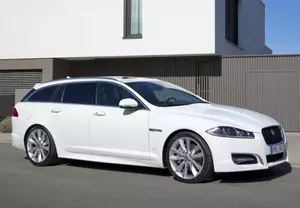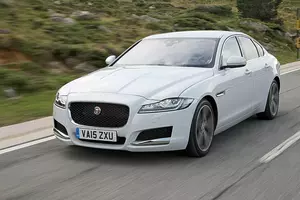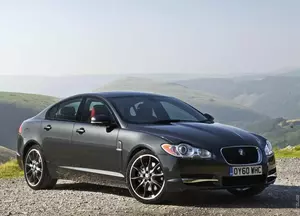
| Vehicle | Curb weight | Difference from world's smallest | Weight to power ratio | 0—60 mph acceleration ratio | Consumption ratio |
|---|---|---|---|---|---|
| 2.0d |
1770 kg / 3903 lbs |
1345 kg (2966 lbs) heavier | 10 kg to 1 hp | 208 kg/s (459 lbs/s) |
354 kg/L (781 lbs/L) |
| 3.0 V6 |
1835 kg / 4046 lbs |
1410 kg (3109 lbs) heavier | 5 kg to 1 hp | 353 kg/s (778 lbs/s) | - |
| 2.0 |
1705 kg / 3760 lbs |
1280 kg (2823 lbs) heavier | 7 kg to 1 hp | 254 kg/s (560 lbs/s) |
251 kg/L (553 lbs/L) |
| 3.0d V6 |
1855 kg / 4090 lbs |
1430 kg (3153 lbs) heavier | 6 kg to 1 hp | 294 kg/s (648 lbs/s) |
325 kg/L (717 lbs/L) |
| 30t |
1763 kg / 3887 lbs |
1338 kg (2950 lbs) heavier | 6 kg to 1 hp | 309 kg/s (681 lbs/s) |
229 kg/L (505 lbs/L) |
| 25t |
1700 kg / 3749 lbs |
1275 kg (2812 lbs) heavier | 7 kg to 1 hp | 258 kg/s (569 lbs/s) |
227 kg/L (501 lbs/L) |
| 30d V6 |
1849 kg / 4077 lbs |
1424 kg (3140 lbs) heavier | 6 kg to 1 hp | 293 kg/s (646 lbs/s) |
303 kg/L (668 lbs/L) |
| 25d |
1800 kg / 3969 lbs |
1375 kg (3032 lbs) heavier | 8 kg to 1 hp | 269 kg/s (593 lbs/s) |
305 kg/L (673 lbs/L) |
| E-Performance 2.0d |
1652 kg / 3643 lbs |
1227 kg (2706 lbs) heavier | 10 kg to 1 hp | 174 kg/s (384 lbs/s) |
324 kg/L (714 lbs/L) |
| 20d |
1714 kg / 3779 lbs |
1289 kg (2842 lbs) heavier | 10 kg to 1 hp | 212 kg/s (467 lbs/s) |
323 kg/L (712 lbs/L) |
| Vehicle | 2.0d |
|---|---|
| Curb weight |
1770 kg / 3903 lbs |
| Difference from world's smallest | 1345 kg (1345 lbs) heavier |
| Weight to power ratio | 10 kg to 1 hp |
| 0—60 mph acceleration ratio | 208 kg/s (459 lbs/s) |
| Consumption ratio |
354 kg/L (781 lbs/L) |
| Vehicle | 3.0 V6 |
| Curb weight |
1835 kg / 4046 lbs |
| Difference from world's smallest | 1410 kg (1410 lbs) heavier |
| Weight to power ratio | 5 kg to 1 hp |
| 0—60 mph acceleration ratio | 353 kg/s (778 lbs/s) |
| Consumption ratio | - |
| Vehicle | 2.0 |
| Curb weight |
1705 kg / 3760 lbs |
| Difference from world's smallest | 1280 kg (1280 lbs) heavier |
| Weight to power ratio | 7 kg to 1 hp |
| 0—60 mph acceleration ratio | 254 kg/s (560 lbs/s) |
| Consumption ratio |
251 kg/L (553 lbs/L) |
| Vehicle | 3.0d V6 |
| Curb weight |
1855 kg / 4090 lbs |
| Difference from world's smallest | 1430 kg (1430 lbs) heavier |
| Weight to power ratio | 6 kg to 1 hp |
| 0—60 mph acceleration ratio | 294 kg/s (648 lbs/s) |
| Consumption ratio |
325 kg/L (717 lbs/L) |
| Vehicle | 30t |
| Curb weight |
1763 kg / 3887 lbs |
| Difference from world's smallest | 1338 kg (1338 lbs) heavier |
| Weight to power ratio | 6 kg to 1 hp |
| 0—60 mph acceleration ratio | 309 kg/s (681 lbs/s) |
| Consumption ratio |
229 kg/L (505 lbs/L) |
| Vehicle | 25t |
| Curb weight |
1700 kg / 3749 lbs |
| Difference from world's smallest | 1275 kg (1275 lbs) heavier |
| Weight to power ratio | 7 kg to 1 hp |
| 0—60 mph acceleration ratio | 258 kg/s (569 lbs/s) |
| Consumption ratio |
227 kg/L (501 lbs/L) |
| Vehicle | 30d V6 |
| Curb weight |
1849 kg / 4077 lbs |
| Difference from world's smallest | 1424 kg (1424 lbs) heavier |
| Weight to power ratio | 6 kg to 1 hp |
| 0—60 mph acceleration ratio | 293 kg/s (646 lbs/s) |
| Consumption ratio |
303 kg/L (668 lbs/L) |
| Vehicle | 25d |
| Curb weight |
1800 kg / 3969 lbs |
| Difference from world's smallest | 1375 kg (1375 lbs) heavier |
| Weight to power ratio | 8 kg to 1 hp |
| 0—60 mph acceleration ratio | 269 kg/s (593 lbs/s) |
| Consumption ratio |
305 kg/L (673 lbs/L) |
| Vehicle | E-Performance 2.0d |
| Curb weight |
1652 kg / 3643 lbs |
| Difference from world's smallest | 1227 kg (1227 lbs) heavier |
| Weight to power ratio | 10 kg to 1 hp |
| 0—60 mph acceleration ratio | 174 kg/s (384 lbs/s) |
| Consumption ratio |
324 kg/L (714 lbs/L) |
| Vehicle | 20d |
| Curb weight |
1714 kg / 3779 lbs |
| Difference from world's smallest | 1289 kg (1289 lbs) heavier |
| Weight to power ratio | 10 kg to 1 hp |
| 0—60 mph acceleration ratio | 212 kg/s (467 lbs/s) |
| Consumption ratio |
323 kg/L (712 lbs/L) |

| Vehicle | Curb weight | Difference from world's smallest | Weight to power ratio | 0—60 mph acceleration ratio | Consumption ratio |
|---|---|---|---|---|---|
| 2.0d |
1740 kg / 3837 lbs |
1315 kg (2900 lbs) heavier | 7 kg to 1 hp | 281 kg/s (620 lbs/s) |
316 kg/L (697 lbs/L) |
| 3.0d V6 |
1750 kg / 3859 lbs |
1325 kg (2922 lbs) heavier | 6 kg to 1 hp | 297 kg/s (655 lbs/s) |
318 kg/L (701 lbs/L) |
| S 3.0 V6 |
1760 kg / 3881 lbs |
1335 kg (2944 lbs) heavier | 5 kg to 1 hp | 352 kg/s (776 lbs/s) |
205 kg/L (452 lbs/L) |
| 3.0 V6 |
1710 kg / 3771 lbs |
1285 kg (2834 lbs) heavier | 5 kg to 1 hp | 335 kg/s (739 lbs/s) |
206 kg/L (454 lbs/L) |
| 2.0 |
1715 kg / 3782 lbs |
1290 kg (2845 lbs) heavier | 6 kg to 1 hp | 312 kg/s (688 lbs/s) |
238 kg/L (525 lbs/L) |
| 30t |
1711 kg / 3773 lbs |
1286 kg (2836 lbs) heavier | 6 kg to 1 hp | 306 kg/s (675 lbs/s) |
228 kg/L (503 lbs/L) |
| 25t |
1629 kg / 3592 lbs |
1204 kg (2655 lbs) heavier | 7 kg to 1 hp | 255 kg/s (562 lbs/s) |
226 kg/L (498 lbs/L) |
| 30d V6 |
1803 kg / 3976 lbs |
1378 kg (3039 lbs) heavier | 6 kg to 1 hp | 296 kg/s (653 lbs/s) |
306 kg/L (675 lbs/L) |
| 25d |
1733 kg / 3821 lbs |
1308 kg (2884 lbs) heavier | 7 kg to 1 hp | 263 kg/s (580 lbs/s) |
309 kg/L (681 lbs/L) |
| 20d |
1644 kg / 3625 lbs |
1219 kg (2688 lbs) heavier | 9 kg to 1 hp | 189 kg/s (417 lbs/s) |
343 kg/L (756 lbs/L) |
| E-Performance 2.0d |
1624 kg / 3581 lbs |
1199 kg (2644 lbs) heavier | 10 kg to 1 hp | 175 kg/s (386 lbs/s) |
346 kg/L (763 lbs/L) |
| Vehicle | 2.0d |
|---|---|
| Curb weight |
1740 kg / 3837 lbs |
| Difference from world's smallest | 1315 kg (1315 lbs) heavier |
| Weight to power ratio | 7 kg to 1 hp |
| 0—60 mph acceleration ratio | 281 kg/s (620 lbs/s) |
| Consumption ratio |
316 kg/L (697 lbs/L) |
| Vehicle | 3.0d V6 |
| Curb weight |
1750 kg / 3859 lbs |
| Difference from world's smallest | 1325 kg (1325 lbs) heavier |
| Weight to power ratio | 6 kg to 1 hp |
| 0—60 mph acceleration ratio | 297 kg/s (655 lbs/s) |
| Consumption ratio |
318 kg/L (701 lbs/L) |
| Vehicle | S 3.0 V6 |
| Curb weight |
1760 kg / 3881 lbs |
| Difference from world's smallest | 1335 kg (1335 lbs) heavier |
| Weight to power ratio | 5 kg to 1 hp |
| 0—60 mph acceleration ratio | 352 kg/s (776 lbs/s) |
| Consumption ratio |
205 kg/L (452 lbs/L) |
| Vehicle | 3.0 V6 |
| Curb weight |
1710 kg / 3771 lbs |
| Difference from world's smallest | 1285 kg (1285 lbs) heavier |
| Weight to power ratio | 5 kg to 1 hp |
| 0—60 mph acceleration ratio | 335 kg/s (739 lbs/s) |
| Consumption ratio |
206 kg/L (454 lbs/L) |
| Vehicle | 2.0 |
| Curb weight |
1715 kg / 3782 lbs |
| Difference from world's smallest | 1290 kg (1290 lbs) heavier |
| Weight to power ratio | 6 kg to 1 hp |
| 0—60 mph acceleration ratio | 312 kg/s (688 lbs/s) |
| Consumption ratio |
238 kg/L (525 lbs/L) |
| Vehicle | 30t |
| Curb weight |
1711 kg / 3773 lbs |
| Difference from world's smallest | 1286 kg (1286 lbs) heavier |
| Weight to power ratio | 6 kg to 1 hp |
| 0—60 mph acceleration ratio | 306 kg/s (675 lbs/s) |
| Consumption ratio |
228 kg/L (503 lbs/L) |
| Vehicle | 25t |
| Curb weight |
1629 kg / 3592 lbs |
| Difference from world's smallest | 1204 kg (1204 lbs) heavier |
| Weight to power ratio | 7 kg to 1 hp |
| 0—60 mph acceleration ratio | 255 kg/s (562 lbs/s) |
| Consumption ratio |
226 kg/L (498 lbs/L) |
| Vehicle | 30d V6 |
| Curb weight |
1803 kg / 3976 lbs |
| Difference from world's smallest | 1378 kg (1378 lbs) heavier |
| Weight to power ratio | 6 kg to 1 hp |
| 0—60 mph acceleration ratio | 296 kg/s (653 lbs/s) |
| Consumption ratio |
306 kg/L (675 lbs/L) |
| Vehicle | 25d |
| Curb weight |
1733 kg / 3821 lbs |
| Difference from world's smallest | 1308 kg (1308 lbs) heavier |
| Weight to power ratio | 7 kg to 1 hp |
| 0—60 mph acceleration ratio | 263 kg/s (580 lbs/s) |
| Consumption ratio |
309 kg/L (681 lbs/L) |
| Vehicle | 20d |
| Curb weight |
1644 kg / 3625 lbs |
| Difference from world's smallest | 1219 kg (1219 lbs) heavier |
| Weight to power ratio | 9 kg to 1 hp |
| 0—60 mph acceleration ratio | 189 kg/s (417 lbs/s) |
| Consumption ratio |
343 kg/L (756 lbs/L) |
| Vehicle | E-Performance 2.0d |
| Curb weight |
1624 kg / 3581 lbs |
| Difference from world's smallest | 1199 kg (1199 lbs) heavier |
| Weight to power ratio | 10 kg to 1 hp |
| 0—60 mph acceleration ratio | 175 kg/s (386 lbs/s) |
| Consumption ratio |
346 kg/L (763 lbs/L) |

| Vehicle | Curb weight | Difference from world's smallest | Weight to power ratio | 0—60 mph acceleration ratio | Consumption ratio |
|---|---|---|---|---|---|
| 2.0 |
1660 kg / 3660 lbs |
1235 kg (2723 lbs) heavier | 7 kg to 1 hp | 221 kg/s (487 lbs/s) |
205 kg/L (452 lbs/L) |
| 2.2d |
1735 kg / 3826 lbs |
1310 kg (2889 lbs) heavier | 9 kg to 1 hp | 214 kg/s (472 lbs/s) |
340 kg/L (750 lbs/L) |
| 3.0 V6 |
1690 kg / 3726 lbs |
1265 kg (2789 lbs) heavier | 7 kg to 1 hp | 214 kg/s (472 lbs/s) |
161 kg/L (355 lbs/L) |
| R-S 5.0 V8 |
1875 kg / 4134 lbs |
1450 kg (3197 lbs) heavier | 3 kg to 1 hp | 426 kg/s (939 lbs/s) |
162 kg/L (357 lbs/L) |
| 3.0d V6 |
1770 kg / 3903 lbs |
1345 kg (2966 lbs) heavier | 6 kg to 1 hp | 290 kg/s (639 lbs/s) |
295 kg/L (650 lbs/L) |
| 5.0 V8 |
1780 kg / 3925 lbs |
1355 kg (2988 lbs) heavier | 5 kg to 1 hp | 330 kg/s (728 lbs/s) |
160 kg/L (353 lbs/L) |
| R 5.0 V8 |
1875 kg / 4134 lbs |
1450 kg (3197 lbs) heavier | 4 kg to 1 hp | 399 kg/s (880 lbs/s) |
162 kg/L (357 lbs/L) |
| Vehicle | 2.0 |
|---|---|
| Curb weight |
1660 kg / 3660 lbs |
| Difference from world's smallest | 1235 kg (1235 lbs) heavier |
| Weight to power ratio | 7 kg to 1 hp |
| 0—60 mph acceleration ratio | 221 kg/s (487 lbs/s) |
| Consumption ratio |
205 kg/L (452 lbs/L) |
| Vehicle | 2.2d |
| Curb weight |
1735 kg / 3826 lbs |
| Difference from world's smallest | 1310 kg (1310 lbs) heavier |
| Weight to power ratio | 9 kg to 1 hp |
| 0—60 mph acceleration ratio | 214 kg/s (472 lbs/s) |
| Consumption ratio |
340 kg/L (750 lbs/L) |
| Vehicle | 3.0 V6 |
| Curb weight |
1690 kg / 3726 lbs |
| Difference from world's smallest | 1265 kg (1265 lbs) heavier |
| Weight to power ratio | 7 kg to 1 hp |
| 0—60 mph acceleration ratio | 214 kg/s (472 lbs/s) |
| Consumption ratio |
161 kg/L (355 lbs/L) |
| Vehicle | R-S 5.0 V8 |
| Curb weight |
1875 kg / 4134 lbs |
| Difference from world's smallest | 1450 kg (1450 lbs) heavier |
| Weight to power ratio | 3 kg to 1 hp |
| 0—60 mph acceleration ratio | 426 kg/s (939 lbs/s) |
| Consumption ratio |
162 kg/L (357 lbs/L) |
| Vehicle | 3.0d V6 |
| Curb weight |
1770 kg / 3903 lbs |
| Difference from world's smallest | 1345 kg (1345 lbs) heavier |
| Weight to power ratio | 6 kg to 1 hp |
| 0—60 mph acceleration ratio | 290 kg/s (639 lbs/s) |
| Consumption ratio |
295 kg/L (650 lbs/L) |
| Vehicle | 5.0 V8 |
| Curb weight |
1780 kg / 3925 lbs |
| Difference from world's smallest | 1355 kg (1355 lbs) heavier |
| Weight to power ratio | 5 kg to 1 hp |
| 0—60 mph acceleration ratio | 330 kg/s (728 lbs/s) |
| Consumption ratio |
160 kg/L (353 lbs/L) |
| Vehicle | R 5.0 V8 |
| Curb weight |
1875 kg / 4134 lbs |
| Difference from world's smallest | 1450 kg (1450 lbs) heavier |
| Weight to power ratio | 4 kg to 1 hp |
| 0—60 mph acceleration ratio | 399 kg/s (880 lbs/s) |
| Consumption ratio |
162 kg/L (357 lbs/L) |